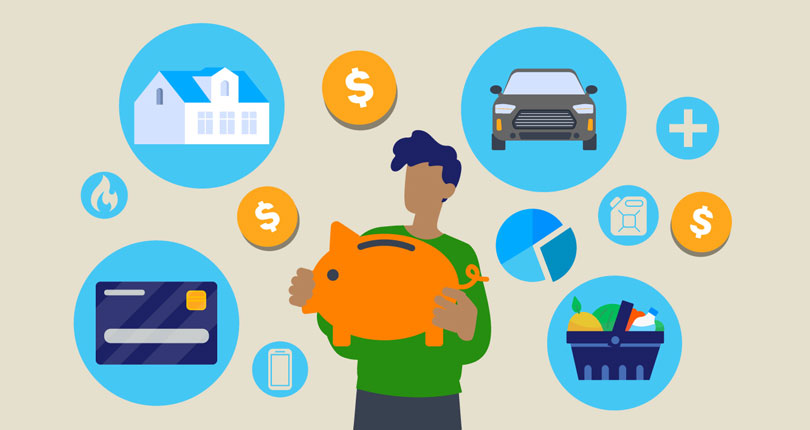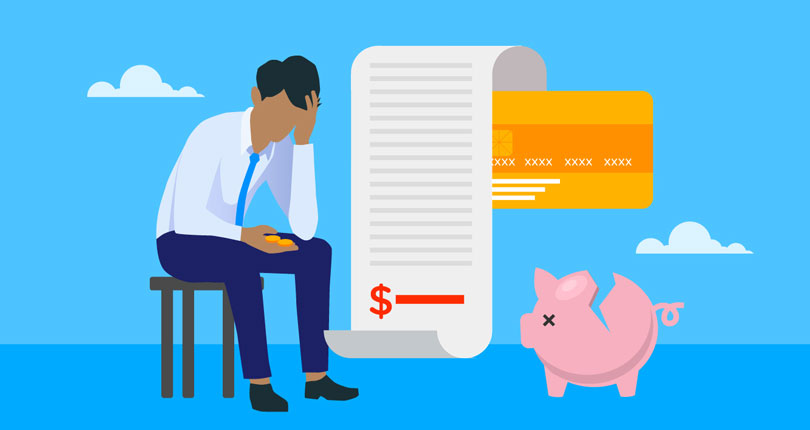How Much Should I Have in Savings?
There is so much information out there about how much money you should have saved by certain points in your life, it can be overwhelming. Like most things, it really depends on the individual, and everybody has a different financial situation.
A survey was conducted on behalf of Self which showed that 92% of respondents currently have a savings account. But does the average person have enough money saved to cover emergency costs? Could they afford to pay their regular bills if they became unemployed? Keep reading to learn about planning your savings for the future, how much the average person has in the U.S. and what emergency expenses typically look like.
Key Statistics
- 8% of Americans in the survey don’t have a savings account at all.
- Two out of five (41.5%) adults have $1000 or less in savings.
- The majority (65.3%) of Americans in the survey have an emergency fund of some sort.
- 77.9% of Americans in the survey have experienced an unexpected emergency cost in the last 12 months.
- 78% of people live paycheck to paycheck and struggle to have enough money left over for savings or investments after paying bills.
- The estimated average amount people spent on emergency expenses over 12 months is $2,821.84, The most common amount people spent on emergencies over 12 months was between $1,000 and $2,500.
Why do I need to have savings?
Having savings is important when it comes to security, planning for uncertainty in life and helping to reduce stress. If you have an emergency fund set aside for unexpected events, you’ll have something to fall back on.
Savings can protect you in the event of a financial emergency, ensuring you can still cover your bills and essential costs. According to a Bankrate survey, 27% of Americans have no emergency savings [1] Bankrate, “Emergency Savings Report 2024” https://www.bankrate.com/banking/savings/emergency-savings-report, with low-income households understandably finding it the most challenging to save.
Checking account vs savings account
When it comes to where to keep your money, the two basic options are your checking account and a savings account. Your income will generally be paid into your checking account, and your regular bills and spending will be paid out of it.
While it might seem easier to keep all of your money in one place, having separate checking and savings accounts offers several important benefits.
- Your checking account should contain the money you need for regular outgoings and spending for the month. The rest you should put into a savings account.
- Most checking accounts don’t earn you any interest on your money, so keeping the majority in savings helps give you a boost of interest.
- You may avoid the temptation to spend more if your money is in a separate savings account.
- Saving towards a goal may be easier if you have your money in a savings pot, or multiple savings pots for different goals.
So what exactly are the key differences between a checking account and a savings account?
| Checking Account |
Savings Account |
| Money you’ll be spending in the short term on bills, groceries and other payments |
Money you don’t plan to spend soon, usually kept for the future or emergencies |
| You could get a debit card for making purchases and withdrawing money |
May have limits on access |
| Lower interest rates earned (if any) |
Higher interest rates earned |
| Transactions are usually not limited |
Some have monthly limits on the number of withdrawals |
How much cash should I have on hand?
These days, most of our money is stored electronically via our bank accounts and debit cards, and cash is being used less frequently. But is it worth keeping some cash on hand?
You might want to keep some of your money in cash in case of an emergency like a power outage that prevents you from accessing your accounts. If you do decide to keep cash at home, make sure it’s stored securely, like in a safe or a locked cabinet.
Emergency funds
An emergency fund is a stash of money you keep in case of a financial emergency. Having one of these funds can take a lot of stress off you if you come up against an unexpected loss of earnings or unforeseen costs.
34.7% of people surveyed don’t have an emergency fund
A survey on behalf of Self found that 65.3% of respondents do have an emergency fund set up to pay for any unexpected costs, but 34.7% don’t have an emergency fund for these expenses.
Why do I need an emergency savings fund?
You need an emergency savings fund to protect yourself against any unexpected costs or financial emergencies. Maybe you lost your job suddenly or your home needed major repair work that couldn’t wait. You want to know you’ve got enough money saved to cover your regular bills due to a job loss or to cover an emergency expense.
How much money should I have in my emergency fund?
The exact amount you’ll need to keep in your emergency fund will vary depending on your lifestyle, income, monthly outgoings and other factors.
This survey found that the estimated average amount people spent on emergency expenses in the past 12 months was $2,821.84. The most common amount people said they spent on emergency costs was between $1,000 and $2,500. 54% of the people surveyed said they used money from their savings to pay for an emergency cost they experienced in the last 12 months.
As of Q4 of 2023, the median income in the U.S. is $59,384 [2] SoFi, “Average Salary in the U.S.” https://www.sofi.com/learn/content/average-salary-in-us/, translating to roughly $4,948 per month. This means you’d have to save just over half of a month’s income to cover the cost of emergencies if you earned the median income.
The exact amount will vary depending on your circumstances and your age. For example, if you’re self-employed, you might want to have a little more saved up in case of a few low-income months. If you rent an apartment, your landlord may be responsible for the cost of fixing appliances, whereas if you own your home you are responsible for fixing them.
Average emergency costs vs months of income
The table below shows how many months of income a person would have to save to cover the estimated average cost of emergency expenses ($2,821.84) for 12 months, based on their annual salary.
| Annual Salary |
Monthly Income |
Months worth of income |
| $10,000 |
$765 |
3.6 months |
| $20,000 |
$1,462 |
1.9 months |
| $30,000 |
$2,114 |
1.3 months |
| $40,000 |
$2,747 |
1 month |
| $50,000 |
$3,367 |
0.8 months |
| $60,000 |
$3,927 |
0.7 months |
For the majority of people earning the median income of just shy of $60k per year, this means the average number of months of take-home pay you’ll want to have saved up is 0.7 months.
However, please also bear in mind that as income increases, often, so does spending on a home, car, etc. Our figures are based on the average cost of an emergency and are to be used as a guideline for what people could expect to pay out across a year for emergency costs only.
How should emergency funds be spent?
Emergency funds should be spent on just that, emergencies. It’s important to keep this money aside specifically for situations that cause financial distress. It might be tempting to dip into it when you’re a little short of cash for lunch with a friend or your favorite store has a sale on, but this could get you into difficulty if a true emergency arises later.
For predictable expenses like birthday gifts, taxes or annual car payments, you should budget for these things out of your regular earnings, or set up a separate sinking fund if you need to spread out the cost over the year. None of these are typically considered emergencies.
Discretionary money
Discretionary money is defined as the amount of income you have left for spending or investing after paying essential bills, taxes and necessities.
Some examples of discretionary spending items include:
- Entertainment, movies and music
- Eating out
- New clothes
- Taking a vacation
- Alcohol and tobacco
It’s important to have discretionary money so you can enjoy new things and experiences in life. But it also gives you something to draw on if you need to save money quickly in unexpected circumstances.
Maybe your car breaks down and needs repairs, or your roof starts leaking, you could cut out a few restaurant dinners or those new shoes you would have bought, and cover these essential costs instead.
But one survey from Payroll.org found that 78% of Americans live paycheck to paycheck and struggle to have money left over for savings or investments after paying their bills [3] Forbes, “Living Paycheck to Paycheck Statistics” https://www.forbes.com/advisor/banking/living-paycheck-to-paycheck-statistics-2024/. For these people, living paycheck to paycheck makes it difficult to save money for emergencies.
Sinking funds
A sinking fund is an amount of money set aside for a one-time predetermined expense. This could be Christmas gifts, a vacation, some new furniture, self-employment tax etc. You’ll be saving this money over a few months or even the whole year so it doesn’t come as a shock when you have to pay for it.
The benefit of having sinking funds set up for these purchases is that if something unexpected comes up, you won’t miss out as you’ll have the money saved already.

How to Get a Credit Card with No Credit
It’s possible to get a credit card
with no credit, but you need to
know which types of accounts to
apply for (and which applications
to avoid as well).
Download our guide
Dealing with unexpected costs
We all come up against unexpected costs from time to time. Life doesn’t always run smoothly and sometimes we need more money than planned to get through the month.
Unexpected expenses include things such as:
- House appliance like a washing machine breaking down
- Your pet needing medical treatment
- A burst pipe which needs urgent repairs
- Travel for a short notice event like a funeral
The best way to deal with these unexpected costs is to have an emergency fund set up ahead of time. Another option would be to re-budget and cut some of your discretionary spending to save the money you need.
77.9% of people have experienced emergency costs in the last year
A survey on behalf of Self asked 1,458 Americans about unexpected costs and found that 77.9% of respondents had experienced an unexpected or emergency cost in the last 12 months.
The types of emergencies people experienced
Survey respondents were able to choose more than one emergency that they experienced in the last 12 months. The most common unexpected cost was a medical emergency, with 33.7% of respondents saying they experienced this.
The next most common unexpected cost was a car accident or car repairs with 26.8%, closely followed by job loss at 22.4%.
How much did emergency events cost people?
This study found that for 22.7% of people, their emergency event cost them between $1,001 and $2,500. This was the most common amount people had to spend, and on either side of this figure, the numbers reduced. Only 3% of those asked said they spent more than $20,000 on their emergency, and 3.6% said they spent less than $100.
Half of people used money from savings to cover emergency costs
When it came to how to pay for unexpected costs, most of our respondents (54%) said they used money from savings. The next most popular answer was that they used money from their regular income.
3.1% of those asked said that they sold some of their belongings to pay for the emergency expense.
How much do emergencies cost on average?
Below is a summary of some of the emergencies Americans might have to deal with in their lifetimes and the average costs associated with each event.
| Type of Emergency |
Average Cost |
| Medical emergency |
$7,530 for an individual plan or $14,700 for a family plan (based on average annual out-of-pocket costs for a Marketplace plan) |
| Replacement roof |
$6,626 |
| New air conditioning unit |
$5,233 |
| Pet emergency |
$1,000 - $2,000 just for diagnostics |
| Dental root canal and crown |
$1,111 + $1,300 |
| Auto transmission replacement |
$2,324 |
| Unexpected travel for an event like a funeral |
$2,000 |
Source [4] NEA, “Prepare Now for These 6 Common Emergency Expenses” https://www.neamb.com/personal-finance/prepare-now-for-these-6-common-emergency-expenses. Costs are a rough guide based on averages but will vary on a case-by-case basis.
Savings by age
Let’s take a look at some of the differences in age groups when it comes to savings goals, and the average amount each group has saved.
Savings goals by age group
Financial goals tend to differ by age group as those in different stages of life will be saving up for different things. Someone in their 20s or 30s might be saving for their first downpayment on a house, whereas those in their 50s or 60s would likely be saving for retirement.
Here’s a guide to approximately how much you should aim to save by age:
| Age |
Amount You Should Aim to Have Saved |
| By age 30 |
1x your annual income |
| By age 40 |
3x your annual income |
| By age 50 |
5x your annual income |
| By age 60 |
7x your annual income |
| By age 70 |
9x your annual income |
| By age 80 |
11x your annual income |
Source [5] Federal Reserve, “Survey of Consumer Finances” https://www.federalreserve.gov/econres/scf/dataviz/scf/table/#series:Transaction_Accounts;demographic:agecl;population:1,2,3,4,5,6;units:mean;range:1989,2019
Remember that these goals will vary depending on a number of things including your income, your planned retirement age and the kind of lifestyle you want to have when you retire.
Average savings by age
A lot of factors affect the savings of different age groups in the U.S. Those who have been in their career longer will have had more time to build up their savings pots. Other things like the economic climate, cost of living and job market all have an effect on savings across different generations.
We’ve talked about how much money you should aim to have saved by certain ages. So, what is the average savings total per age group in the U.S according to the Federal Reserve Board’s 2022 Survey of Consumer Finance.
| Age Group |
Average Savings |
| Under 35 |
$20,540 |
| 35-44 |
$41,540 |
| 45-54 |
$71,130 |
| 55-64 |
$72,520 |
| 65-74 |
$100,250 |
| 75 and Over |
$82,800 |
Source [5] Federal Reserve, “Survey of Consumer Finances” https://www.federalreserve.gov/econres/scf/dataviz/scf/table/#series:Transaction_Accounts;demographic:agecl;population:1,2,3,4,5,6;units:mean;range:1989,2019
Advice shows that based on a median salary of $59,384, Americans aged 45-54 should aim to have $296,920 saved. [5] Federal Reserve, “Survey of Consumer Finances” https://www.federalreserve.gov/econres/scf/dataviz/scf/table/#series:Transaction_Accounts;demographic:agecl;population:1,2,3,4,5,6;units:mean;range:1989,2019 But stats show that the average amount of savings for this age group is only $71,130.
Two in five people have $1,000 or less in savings
A survey on behalf of Self shows that 41.5% of Americans currently have $1000 or less in savings, and only 7% have over $50,000. Take a look at the full breakdown in the chart below.
Saving for life events
There are plenty of costly life events that you might need to save for throughout your lifetime. Let’s take a look at some of the most common life events and large purchases people have to consider.
Savings needed for a wedding
In the U.S., the average cost of a wedding in 2024 is $33,000 [6] Forbes, “Average Cost of a Wedding” https://www.forbes.com/advisor/personal-loans/average-cost-of-a-wedding/. Typically the venue is the most expensive part of a wedding, ranging from $6,000 to $12,000 for the day. Depending on the kind of wedding you want to have and the location, the total amount can vary a lot.
The best way to save for a wedding is to set up a separate fund and create a budget for each part of the wedding you need to pay for. This way you can keep track of your spending and set priorities for the things you really need to include.
Savings needed for buying a house
When saving for a house, general advice is to save around 25% of the house’s sale value as a downpayment and to cover associated closing costs and moving expenses. So if the house you want to buy is $300,000, you’d try and save $75,000 as your initial payment. [7] Ramsey Solutions, “How Much Money Do I Need to Buy a House?” https://www.ramseysolutions.com/real-estate/how-much-money-do-i-need-to-buy-a-house The rest you’ll pay off over time with a mortgage. But how much you save for a downpayment really depends on your circumstances and what you can afford.
Remember that when it comes to buying a house, there are lots of other things to pay for outside of the downpayment. These include inspections, closing costs and possibly attorney fees. It’s important to take these things into consideration when saving to buy a house.
Savings needed for having a baby
Having a baby comes with a lot of costs, from the pregnancy, to giving birth, to caring for the baby when they’re born. A normal pregnancy, childbirth and postpartum care can total an average of $18,865, resulting in an average of $2,854 out-of-pocket for people enrolled in health insurance plans. [8] How Much Does a Baby Cost? https://www.northwesternmutual.com/life-and-money/how-much-money-does-a-baby-cost-are-you-ready-for-a-baby/ Costs for additional tests and other treatment you might need are often not covered by insurance.
The amount people spend on caring for a baby in their first year of life is around $13,000, not including labor and delivery. [9] American Heritage, “What a Baby Costs in the First Year” https://www.americanheritagecu.org/about-us/american-heritage-and-the-community/blog/moneyblog/2023/10/05/what-a-baby-costs-in-the-first-year If you’re part of a couple, you’ll also need to consider whether you or your partner will leave work to care for your child full time. If this is the case you would lose one source of income, but alternatively there would be childcare costs to pay if you both continued working.
Saving for your children’s college education
Sending your child to college can be extremely costly, so setting up a savings fund for this when your child is born will give you the best chance of saving enough money. If you start investing at your child’s birth, the growth and interest earned over 18 years could go a long way towards supporting their college fund.
Depending on the type of college your child goes to, the costs can vary. The average cost of one year at a four-year public in-state college is $11,260, whereas a four-year private college costs roughly $41,540 per year (not including room and board). [10] Collegeboard.org “Trends in College Pricing” https://research.collegeboard.org/trends/college-pricing/highlights
| Life Event |
Average Cost |
| Wedding |
$33,000 |
| Buying a House |
$75,000 (based on 25% of a $300,000 home) |
| Having a Baby |
$15,854 (Based on a normal pregnancy and the child’s first year of life.) |
| Children’s College Education |
$41,540 (Per year for a four-year private college, not including room and board.) |
How much should I save each month?
Most financial experts recommend saving around 20% of your income every month. Using the 50/30/20 rule, 50% of your income should be spent on essential bills and food, 30% for discretionary spending, and 20% for your savings pot.
Of course, this may be different depending on individual circumstances and incomes. Someone who is younger with fewer responsibilities might be able to save more than someone who has a larger family to feed. Or alternatively, someone who is older and has a stable career with investments in place might be able to save more.
How can I grow my savings?
There are several ways to save and invest in order to make your money go further, and to give your savings a boost. Take a look at some of the options available.
Five ways to grow your savings
- High Yield Savings Accounts - These are similar to standard savings accounts, but they offer higher interest rates. You might need a larger initial deposit for a high yield account.
- Certificates of Deposit - You’ll need to keep your money in a CD for a specified amount of time (between 6 months and 5 years) but the interest rates are higher than savings accounts.
- Bonds - These are typically lower-risk debt investments issued by companies, municipalities, states, and governments for certain projects. Bonds are issued at a fixed interest rate for a specific amount of time. The issuer pays interest during this period and returns the bond’s face value to you when it matures.
- Treasury Bills - Also known as T-Bills, Treasury Bills are short term securities which take one year or less to mature. You purchase T-Bills at less than their full value, when a Bill matures, the Treasury pays you its full value.
- Money Market Funds - A money market mutual fund only invests in low risk securities. They usually provide similar returns to short-term interest rates. You’ll need to do some research to find a money market fund which has been performing well.
Methodology
1,458 American adults were surveyed between February 15 and February 25, 2022, asking questions related to emergency costs and savings. The survey was carried out using the Amazon Mechanical Turk platform, and data from respondents represents U.S. adults aged 18 or older.
The respondents’ age ranges were:
- 9.2% - 18 to 24 years old
- 39.2% - 25 to 34 years old
- 28.3% - 35 to 44 years old
- 12.6% - 45 to 54 years old
- 7.4% - 55 to 64 years old
- 3.3% - 65+ years old
The respondents’ genders were:
- 55.2% - Female
- 43.4% - Male
- 1.2% - Non-binary
Sources
- [1] Bankrate, “Emergency Savings Report 2024” https://www.bankrate.com/banking/savings/emergency-savings-report
- [2] SoFi, “Average Salary in the U.S.” https://www.sofi.com/learn/content/average-salary-in-us/
- [3] Forbes, “Living Paycheck to Paycheck Statistics” https://www.forbes.com/advisor/banking/living-paycheck-to-paycheck-statistics-2024/
- [4] NEA, “Prepare Now for These 6 Common Emergency Expenses” https://www.neamb.com/personal-finance/prepare-now-for-these-6-common-emergency-expenses
- [5] Federal Reserve, “Survey of Consumer Finances” https://www.federalreserve.gov/econres/scf/dataviz/scf/table/#series:Transaction_Accounts;demographic:agecl;population:1,2,3,4,5,6;units:mean;range:1989,2019
- [6] Forbes, “Average Cost of a Wedding” https://www.forbes.com/advisor/personal-loans/average-cost-of-a-wedding/
- [7] Ramsey Solutions, “How Much Money Do I Need to Buy a House?” https://www.ramseysolutions.com/real-estate/how-much-money-do-i-need-to-buy-a-house
- [8] How Much Does a Baby Cost? https://www.northwesternmutual.com/life-and-money/how-much-money-does-a-baby-cost-are-you-ready-for-a-baby/
- [9] American Heritage, “What a Baby Costs in the First Year” https://www.americanheritagecu.org/about-us/american-heritage-and-the-community/blog/moneyblog/2023/10/05/what-a-baby-costs-in-the-first-year
- [10] Collegeboard.org “Trends in College Pricing” https://research.collegeboard.org/trends/college-pricing/highlights







